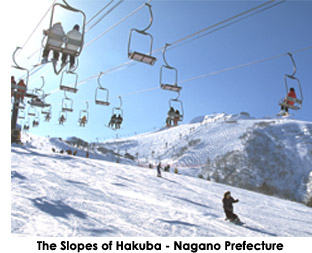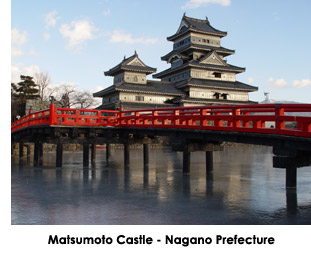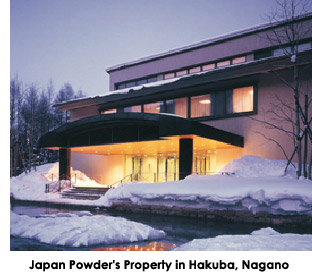Australian Investors Ski into Nagano
May 05, 2008

After blazing a trail of success in Hokkaido, savvy Australian investors are now on the lookout for further ski development opportunities in Japan. With well-maintained infrastructure, attractive property prices and easy access from Tokyo, the slopes of Nagano's Hakuba region in particular are already attracting plenty of Aussie interest.
Australians are certainly no strangers when it comes to Japan’s ski fields. Much to the surprise of most Japanese, it was Australian investors who almost single-handedly started the development boom in the ski area of Niseko, Hokkaido. Once a rural locality in the throes of serious social and economic decline, today Niseko is regarded as a world-class skiing destination, and enjoys full occupancy during the busy snow season. The area is also now home to the fastest rising land prices in the land of the rising sun.

With all of the action in Japan’s north however, the traditional ski areas located in mainland Japan; namely Nagano, Yamagata and Niigata, have been largely overlooked by both domestic and foreign investors. Ski businesses in these prefectures had fallen on hard times following the decline in Japanese skier numbers and the greying population, leading many to believe that ski resort investment in Japan had come and gone with the bubble. Niseko’s success, however, is forcing property developers to take another look.
The rise, fall and rise of these ski fields bear a very similar resemblance to the track record of Japan’s economy over the past two decades. Just after the height of the bubble, Japanese skiers peaked at a staggering 17.6 million in 1992; fuelled in part by popular films such as “Watashi-wo Ski-ni Tsuretette!” (Take Me Skiing!). Property developers had also invested liberally during this time, and to this day Japan houses more than seven hundred winter resorts with some of the best ski infrastructure in the world.
As the economy hit the skids shortly after in 1994, so too did interest in skiing. The empty slopes of Nagano, Niigata and Yamagata followed the Japanese economy into a prolonged period of stagnation, which even the 1998 Nagano Winter Olympics could not abate. By 2005, the “ski bubble” had well and truly popped, with the Japan Productivity Centre for Socio-Economic Development estimating that the number of skiers in Japan had nosedived to just 12.5 million.
 The tourist figures for Nagano reflected this grim reality: In 1992, Nozawa-Onsen ski resort in Nagano had a record 1.1 million visitors. By 2004, the number of visitors had plummeted to just 380,000.
The tourist figures for Nagano reflected this grim reality: In 1992, Nozawa-Onsen ski resort in Nagano had a record 1.1 million visitors. By 2004, the number of visitors had plummeted to just 380,000.Ski resort investment in Japan remained a fairly unattractive proposition up until the boom in Niseko, which has enjoyed a tenfold increase in the number of foreign skiers over the past five years. Sensing great potential in Nagano to recreate Niseko’s strategy of targeting foreign skiers, suddenly property developers are beginning to take note of the area’s low property prices and easy access to Tokyo.
Japan Powder is one such development company who has grabbed at the opportunity. Their Australia-based consortium bought a hotel in Nagano’s Hakuba area at a bargain price from a bankrupt Japanese company – a victim of Japan’s bubble era recession from the decade before. Lavishly decorated and literally moments from the slopes of Hakuba, the hotel was once a company retreat for employees, but now Japan Powder is converting the building into a family-style ski hotel in time for the 2008 season.
Josh Norris, Director of Japan Powder, is quietly confident of success in the region. “We see great potential for growth in Nagano,” says Josh. “The quality of snow here offers some of the best skiing in the world. The Olympics have been held here, and yet property prices are surprisingly good when compared to Niseko.”
Josh also believes that the proximity of Nagano’s ski slopes to Japan’s major cities is an important advantage in attracting foreign tourists. “Access from the international airports in Tokyo and Nagoya is simple and fast. Both of these cities are also serviced by discount international carriers from Australia and Asia, and we believe these markets will be more important than the Japanese market itself.”
 “Also, the Japanese shinkansen [bullet trains] allow you to be in Hakuba just a few hours after you land,” Josh adds. “Considering the benefits in time zones and access when compared to destinations like Canada or even Niseko, we think we are onto a winner here.”
“Also, the Japanese shinkansen [bullet trains] allow you to be in Hakuba just a few hours after you land,” Josh adds. “Considering the benefits in time zones and access when compared to destinations like Canada or even Niseko, we think we are onto a winner here.”Another advantage Nagano offers to visitors is the flexibility to combine skiing with sightseeing and other cultural activities. Nagano apples, pickles and noodles are famous throughout Japan, as are the prefecture’s hot spring baths. Matsumoto Castle in Nagano is World Heritage listed, and the hustle and bustle of Tokyo is less than two hours away by train.
Others developers have already begun to follow in Japan Powder’s footsteps. Interestingly, the Hakuba Chamber of Commerce has noted a sudden spike in foreign investment into the region, and also recorded over 35,000 foreign skiers visiting the area in 2007. In combination with the gradual rejuvenation of many ski companies in the area by domestic investment, competition is sure to pick up quickly.
Nagano also featured in the April edition of The Australian newspaper’s magazine, Wish, who labelled skiing in Hakuba as ‘one of Japan’s best kept secrets.’ With lift tickets under half the price of those in Australia, and some of the best snow in the world, it is only a matter of time until the secret becomes a real option for Australian and Asian snow lovers.
- Fred Taylor, JETRO Sydney
PDF Version of this Article





